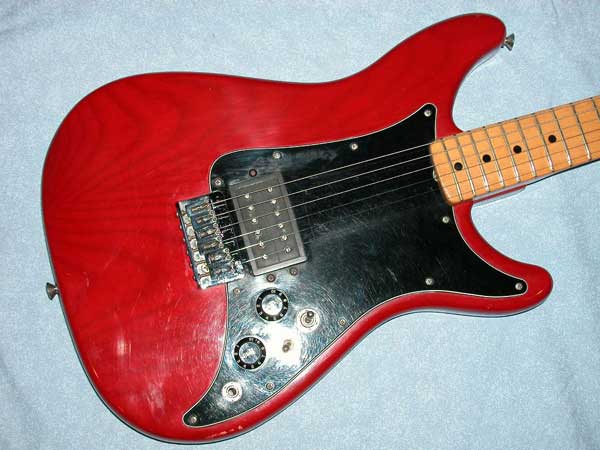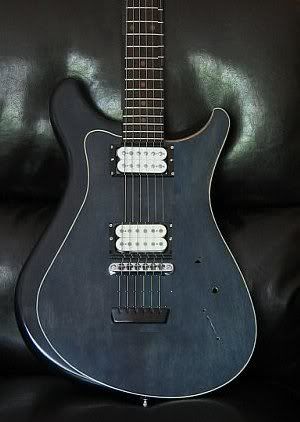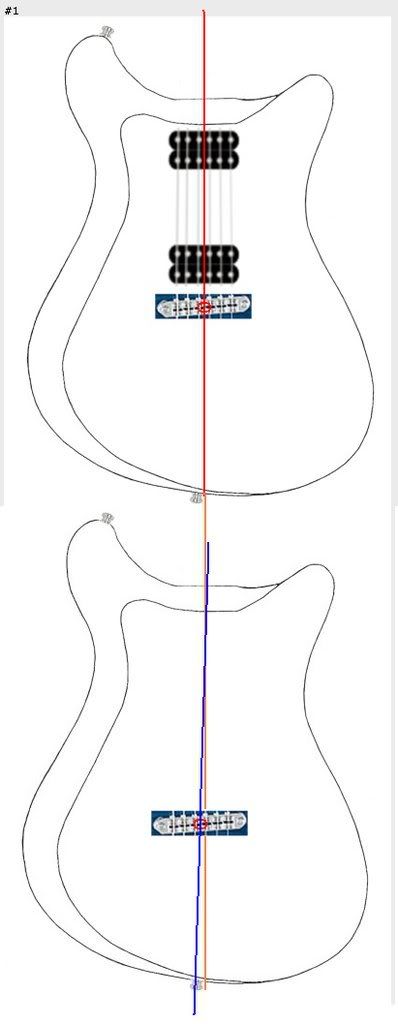ohm-men wrote:
How does it play?
It's quite nice. The acoustic sound is pretty loud and full. Compared to my G&L Legacy, the unplugged sound isn't as snappy, and has more low mid, with a bit more sustain. I'm not saying it's better than my G&L, which is a *fantastic* guitar. Just that my design departs from the typical Strat sound, but is still in Fender territory despite the shorter scale (see below).
Plugged in, both pickups produce very nice tones. The neck pickup is a Seymour Duncan Alnico II pro, which sounds great clean or with some overdrive. It gets a bit muddy with more gain though. The bridge pickup is a Bill Lawrence L-450. It's the second time I use it in a guitar, and it sounds really good, both clean, overdriven, or using high gain settings. I still have to try it in a tube amp, but I'm pretty sure it'll shine there too. It's a low output pickup, which has a very tight sound, not too twangy, but bright and clear. I love it. The middle position on the 3 way switch is the outer coils of both pickups in parallel, which gets you some nice Strat twang, very similar to what you'd get on Strat in position 2 (middle + bridge).
The tone pot has a very low value capacitor (0.0022uf) that gets you a mid-boost effect on the 0 position, which is particularly interesting in position 2 (outer coils in parallel). The in-between tones are kinda blah though. I'm working on a different configuration, using a 4 way switch, with the 3 existing pickup selections, but with a 4th (position 2) adding a "tone-switch" to the parallel outer coils, that'll replace the tone pot. It'll be a 4-way rotatery switch with different value capacitors in the 0.0022uf to 0.01uf range, which produces different mid-boosts by cutting some of the highs while still retaining some clarity and volume. It's the equivalent of having a choice of 4 different tone pots all set to 0.
If you were wondering, I don't think ash necks have any advantages compared to maple necks. It seems just as stiff, and gives you just as bright a tone as far as I can tell. It's more difficult to finish though, since you need to fill the grain, so that might be why you don't see it used much, if at all, on production guitars. The neck on this guitar doesn't flex much under tension using .010-.046 strings, probably because of the pretty fat profile, which is .900 at the 1st fret and .950 at the 12th. I based this on a neck I ordered some years ago from USA Custom Guitars. I'd be curious to see how thinner ash necks perform, but I'm pretty sure it'd be just as stiff as maple.
The scale length was supposed to be 25". It ended up as 24.875" by mistake, because I tried to be clever. I figured out one day that I could use a 1/4"-20 threaded rod to make a jig to fabricate my own fret scale templates. The jig was awfully complicated, and required me to count the number of revolutions between frets (i.e. 10 and 1/8 of a turn to the next fret), but it worked. However, I discovered too late that hardware store 1/4"-20 rod isn't precisely, machinist approved, 20 threads per inch. It's roughly 20 threads per inch. So by the time I got to the 12th fret, I was already off by 1/16", shortening the effective scale length by 1/8". Hence, 24.875" instead of 25".
At first, I was sure I had missed a few turns of the screw here and there, and thought the fretboard was totally useless. I almost threw it out, but always ended up storing it away, until one day (a few years later) when I got a digital caliper, and compared measurements taken on the fretboard to what a 25" scale length was supposed to be, and realized that every fret was off, but consistently so up to the 23rd fret. This meant that I had a usable 24.875" scale fretboard.
The guitar has 23 frets. I wish I had a good story there too, but I don't. This guitar build started 4 years ago, and judging from the neck pocket, the neck's heel and the bridge placement, I really meant to have 23 frets there. I just don't remember why. (Luckily the TOM saddle had just enough forward travel to compensate for the 24.875" scale, a full 1/8" shorter than the scale I thought I was working with at the time.)
ohm-men wrote:
How did you do the strings thru body?Did you use regular ferulles for this?
I simply drilled halfway from both sides, to make sure that holes ended up evenly spaced on both sides of the body. Yes, there are regular ferrulles on the back.
The guitar isn't only string-through though. The idea behind the wooden bridge was to allow both string-through or top-loading strings. I could have 3 strings through, and 3 top-loaded if I wanted. That's why I made my own tailpiece in the first place. You can see how it's done in the original Autocad drawing :


ohm-men wrote:
Could you shed any light on how far aft the bridge these ferulles should be.
It depends in part on how high the bridge will end up and the neck angle. The higher the bridge and steeper the angle, the farther away you can put the tailpieces/string-through ferrules. The lower the bridge, the closer you need the string to be to get enough pressure on the bridge saddles. I don't think there's a definitive answer. See what works before drilling! I wish I put the tailpiece just a bit closer to the bridge on this one for aesthetic reasons, but it works fine as is.




the 2nd one looks just like an offset version of the fender lead

























